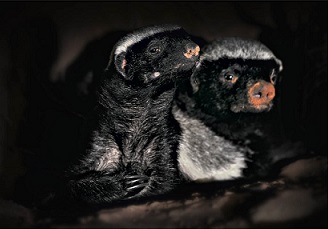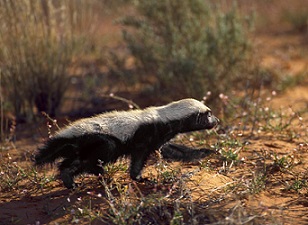Let's Get Busy!
Honey badgers have been shown to have a lifestyle that is unique
to the honey badger in respect to other mustelids. Typically other
mustelidae, which includes badgers, weasels, minks etc., exhibit a
pattern of intrasexual territoriality (Begg, et al., 2006).
Intrasexual territoriality is defined as males fighting with other
males for dominance. With that dominance, comes the choice of mates,
and the right to certain territories.
 Honey badgers, however, make
their own path when it comes to their reproduction habits. Males
will have expansive home-ranges, which will overlap the much smaller
home ranges of the female honey badgers(Begg et al., 2006). Up to 13 home-ranges of
female honey badgers can be encompassed by a single male. The word
“home-range” is the total area that a single honey badger will use.
(Begg et al., 2006). The home-ranges of males are drastically larger
than those of the female population. The home-ranges of the males
average around 541 km2, where female home ranges average around 126
km2 (Begg et al., 2006).
Honey badgers, however, make
their own path when it comes to their reproduction habits. Males
will have expansive home-ranges, which will overlap the much smaller
home ranges of the female honey badgers(Begg et al., 2006). Up to 13 home-ranges of
female honey badgers can be encompassed by a single male. The word
“home-range” is the total area that a single honey badger will use.
(Begg et al., 2006). The home-ranges of males are drastically larger
than those of the female population. The home-ranges of the males
average around 541 km2, where female home ranges average around 126
km2 (Begg et al., 2006).
The lack of territoriality is shown by the overlapping
home-ranges of the males in the population. In one study, it was
shown that male home-ranges overlapped by around 74%, with some
badgers completely overlapping others.(Begg et al., 2006) Females, on the other hand,
showed different patterns of overlapping in their home ranges. The
percentages of their home-ranges varied from a 5.5% overlap, to a
38% overlap. The average home range overlap in females was shown to
be around 13% (Begg et al., 2006). Compared the the average home
range of the males, there is a 61% difference. Because of this small
overlap of home-ranges in respect to male honey badgers, females
were never seen to interact with one another. In fact, the closest
that two female honey badgers were seen was 2.6km away (Begg at al.,
2006).
Males and Females also showed differences when it came to moving
out of the den. Honey badgers will live in their mother’s den for a
certain period of time until they become independent. A study
defined the badgers as being independent when they were away from
their mothers for more than two days, and they were foraging
independently from their mothers(Begg et al., 2006). Female honey badger cubs, once
independent, were shown to travel much farther from their mother’s
den than their male counterparts. Within two weeks of the female
cubs newfound independence, they had travelled over 23km away from their mother’s
den. Males on the other hand, traveled away for approximately two
months, but then went back to rejoin his mother in her den (Begg et
al., 2006). This is a drastic difference as females were never observed
returning to their mothers.
independence, they had travelled over 23km away from their mother’s
den. Males on the other hand, traveled away for approximately two
months, but then went back to rejoin his mother in her den (Begg et
al., 2006). This is a drastic difference as females were never observed
returning to their mothers.
As for reproduction of honey badgers, they are shown to have
polyamorous mating habits. In other words, males travel and mate
with multiple females, never establishing family units (Begg et al.,
2006). Females,
once impregnated, will shelter the cubs in their dens for a period
of time. Adult male cubs were never seen caring for, hunting for, or
otherwise being involved with cubs. Typically, females will only
have and care for a single cub at a time. Gestation is estimated
around 50-70 days, which is higher than other, smaller mustelids.
Honey badgers do not show a cyclical mating season. Instead, the
honey badgers exhibit asynchronous reproduction, birthing throughout
the year (Begg et al., 2006)
The honey badger is overall a non-social species due to reproductive and parental patterns of honey badgers studied. Unique from its other mustelid counterparts, it shows great deviation from the rest of its family. It could be the unique features and behaviors possessed by the honey badger that make it such an adaptive and successful animal.
See how the honey badger interacts with other species by visting the Interactions page.
